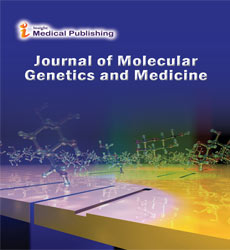Molecular Genetic Trying Out and the Future of Scientific Genomics
Amita Verma*
Department of Pharmaceutical Sciences, Bio-organic and Medicinal Chemistry Research Laboratory, Sam Higginbottom University of Agriculture, Technology and Sciences, Allahabad, Uttar Pradesh, 211007, India
- *Corresponding Author:
- Amita Verma
Department of Pharmaceutical Sciences
Bio-organic and Medicinal Chemistry Research Laboratory
Faculty of Health Sciences
Sam Higginbottom University of Agriculture
Technology and Sciences
Allahabad, Uttar Pradesh, 211007, India
E-mail: amitaverma.dr@gmail.com
Received Date: October 5, 2021; Accepted Date: October 19, 2021; Published Date: October 26, 2021
Citation: Verma A (2021) Molecular Genetic Trying out and the Future of Scientific Genomics. J Mol Genet Med Vol.5 No.1:005
Description
Genomic generation are achieving the issue of being able to stumble upon genetic version in patients at immoderate accuracy and reduced cost, supplying the promise of basically converting medicine. Still, despite the fact that scientists and insurance advisers grapple with the manner to interpret and the manner to cope with the onslaught and ambiguity of genome- sizeable data, installation and well-showed molecular generation maintain to have an important role, especially in regions of the area that have more restrained access to next- generation sequencing capabilities. Here we evaluation the form of techniques currently available in a scientific setting similarly to growing processes in scientific molecular diagnostics. In parallel, we outline implementation annoying conditions so one can be vital to deal with to make certain the future of genetic medicine.
The scope of scientific genetic trying out
Genetic finding out has grown from a gap specialty for unusual problems to an extensive scope of programs for complex disease and personal use. Not surprisingly, the definition of a genetic test has changed due to the fact the programs have evolved. Applications of scientific genetic finding out span clinical disciplines, including: new infant screening for surprisingly penetrant problems; diagnostic and carrier finding out for inherited problems; predictive and pre-symptomatic finding out for adult-onset and complex problems; and pharmacogenetic finding out to guide person drug dosage, desire and response . Currently, genetic tests may be indicated in one-of-a-type scientific contexts and ordered through multiple health-care centers.
Post-millennium genetic era
For the most part, scientific molecular diagnostic era live centered on identifying patients’ is underlying pathogenic mechanisms. Summarizes the methodologies which are probably applicable to heritable genotypes and karyotypes. With direct genetic finding out, the laboratory appears for the best genetic version (or versions) that contributes to a condition, even as indirect genetic finding out relies on the assessment of DNA markers which is probably linked to a trait of interest but that do not motive the genetic condition.
Causal disease variants
In scientific diagnostic genetic finding out, the American College of Medical Geneticists81 recommends that versions be assigned to one of the following six categories:
• ‘Disease causing’: collection version has previously been said and is a identified motive of the disease (for example, deletion of F508 in CFTR);
• ‘Likely disease causing’: collection version has now not previously been said and is of a type predicted to motive the disease, generally in a mentioned disease gene (for example, a non-sense mutation in a gene for which exclusive mutations of this type, but at a one-of-a-type residue, have been said);
• ‘Possibly disease causing’: collection version has now not previously been said and is of the sort that might or may not be causative of the disease;
• ‘Likely now not disease causing’: collection version has now not previously been said and is probably now not causative of disease;
• ‘Not disease causing’: collection version has previously been said and is a identified unbiased version;
• ‘Variant of unknown scientific significance’: collection version is not mentioned or expected to be causative of disease but is decided to be associated with a scientific presentation.
• Clinical molecular genetic finding out is transforming personalized remedy and is appropriate for a range of programs, including unusual disease diagnostics and predictive finding out for now no longer unusual problems.
• Whole-exome and whole-genome sequencing also can moreover grow to be a first-line scientific test for some naive diagnostic cases, but traditional genetic tests will continue to be used for the immoderate analytical sensitivity of specific defects and for the confirmation of genome findings.
• There remains no single test to stumble upon the large variety of genetic defects that may be inherited or upward thrust up de novo; scientific diagnostics requires multiple processes to determine a causal genetic defect.
• Although genome sequencing also can moreover transform diagnostic processes in massive educational clinical centres, access to high-priced and complicated tests are not universal. Genetic finding out should be available globally via showed smooth era for molecular diagnostics (including direct PCR, linkage assessment or multiplex ligation-mounted probe amplification).
• The excellent project to scientific genomics is the reliable interpretation of the multiple and no vel ver sions decided via genome sequencing. Pathogenicity of genetic versions can be examined with bioinformatics prediction processes, protein stability studies, transcriptional interest studies and allele- and gene-specific animal models.
• As broader genomic facts become available to vendors and patients, partnerships will expand to supply affected individual-centered data, including incidental findings. The regulatory environment should adapt to the upcoming quantity of genomic facts to maximize benefit to patients and health-care systems and to wholesome the expectations of the affected individual population with reference to the ones technology.
Open Access Journals
- Aquaculture & Veterinary Science
- Chemistry & Chemical Sciences
- Clinical Sciences
- Engineering
- General Science
- Genetics & Molecular Biology
- Health Care & Nursing
- Immunology & Microbiology
- Materials Science
- Mathematics & Physics
- Medical Sciences
- Neurology & Psychiatry
- Oncology & Cancer Science
- Pharmaceutical Sciences
